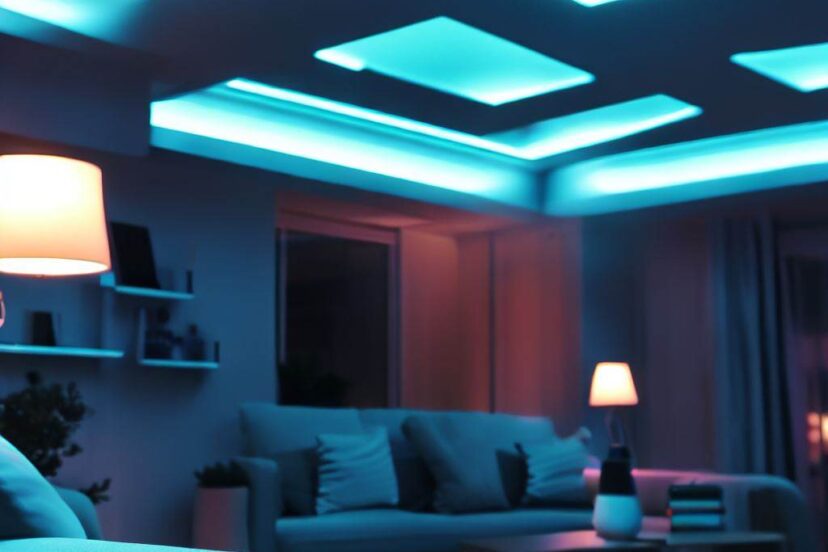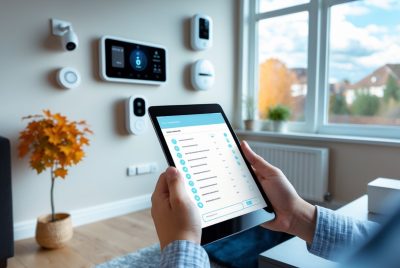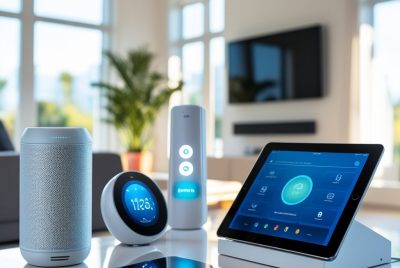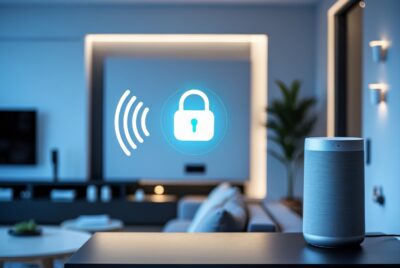Home Automation Lights: Lighting Up the Future
*We may earn a commission for purchases made using our links. Please see our disclosure to learn more.
Home Automation Lights: Transform Your Living Space with Intelligent Lighting
Home Automation Lights and Smart lighting are changing the way we illuminate our homes. As I explored the best options in smart lighting, I noticed the flexibility and automation features they offer, making our daily routines more convenient. Whether it’s setting the perfect ambiance for a movie night or ensuring the lights turn off when I leave the room, smart lights adapt to my needs seamlessly.

I found that the best smart light systems don’t require a hub and can integrate with major voice assistants like Alexa, Google Assistant, and Apple HomeKit. This means I can control them with simple voice commands or automate them to fit my lifestyle. From dimmable bulbs to color-changing strips, there’s a smart light for every part of my home.
One major advantage of smart lighting is the ability to automate and schedule lights based on my daily habits. For instance, I can have my desk lamp flash when my Uber arrives or set lights to turn on at sunset. This not only adds convenience but also enhances home security by making it look like someone is always home.
Understanding Home Automation Lights

Home automation lights have evolved over time, integrating advanced technologies. They offer various benefits such as energy efficiency and convenience, using different types of lighting technologies to suit various needs.
History and Evolution
Smart lighting started simple with basic timers used to turn lights on and off at set times. Early systems were limited and expensive, designed mostly for businesses or high-end homes. With time, technology improved, and costs decreased, making smart lighting more accessible.
The development of wireless technology and the Internet of Things (IoT) led to a surge in home automation. Now, lights can be controlled via voice commands, apps, or even automated routines. This evolution has made smart lighting a standard feature in modern homes.
Types of Smart Lighting Technologies
There are various types of smart lighting technologies available today, each with its unique features.
- Wi-Fi Enabled Lights: These connect directly to your home Wi-Fi network and can be controlled via a smartphone app.
- Bluetooth Lights: These are controlled through a smartphone or tablet but require you to be within Bluetooth range.
- Zigbee and Z-Wave Lights: These use a hub to connect to your home network and offer reliable, long-range communication.
Many lights now come with dimming capabilities, color-changing features, and compatibility with voice assistants like Alexa, Google Assistant, and Siri.
Benefits of Automated Lighting
Automated lighting offers several key benefits.
- Energy Efficiency: Automated lights can save energy by turning off when not needed. Sensors can detect when a room is empty and switch lights off, reducing electricity bills.
- Convenience: You can control lights remotely through an app or voice commands, making it easier to manage your home’s lighting.
- Customization: Automated systems allow for personalized settings. You can create routines where lights change color or brightness based on the time of day or specific events.
- Security: Automated lights can deter burglars by simulating occupancy when you’re not home. Integrating with other smart home devices, they can also respond to alarms.
The combination of these benefits makes automated lighting an attractive addition to any modern home, enhancing both functionality and security.
Setting Up Your Automated Lighting System

To set up an automated lighting system, you’ll need to choose smart bulbs, install and configure them, and integrate them with home automation platforms. Each step is crucial for a seamless experience.
Choosing the Right Smart Bulbs
Selecting the right smart bulbs is the first step. Smart bulbs come in various types, including LED, incandescent, and halogen. Most smart bulbs connect through Wi-Fi, Bluetooth, or a smart hub like Zigbee or Z-Wave. It’s important to check compatibility with your existing light fixtures and home network.
Consider features like color-changing options, dimmability, and energy efficiency. Brands like Philips Hue, LIFX, and Sylvania are popular choices. Reading reviews and comparing specs can help make a decision. Make sure your chosen bulbs work with your home automation ecosystem.
Installation and Configuration
Installing smart bulbs is usually straightforward. First, screw in the bulb just like any traditional bulb. Next, download the app that corresponds to your bulb. Most apps provide step-by-step instructions. Connecting the bulb to your Wi-Fi or smart hub is often the next step.
If you run into issues, FAQs and community forums are helpful resources. Ensure your smart bulbs are connected to a stable network and within range of your hub. You might also need to update the firmware through the app, so keep an eye out for updates.
Integration with Home Automation Platforms
Integrating your smart bulbs with home automation platforms like Apple HomeKit, Google Home, or Amazon Alexa enhances functionality. Most platforms allow voice control and automation routines. Start by adding the bulbs to your chosen platform’s app.
Select pre-set scenes or create custom ones for activities like reading, movie night, or early morning routines. Setting schedules ensures your lights turn on or off based on daily routines. You can also link your smart bulbs with other devices like motion sensors for automatic lighting control.
By carefully choosing, installing, and integrating your smart bulbs, you can enjoy a fully automated lighting system.
Control Methods for Automated Lights

Automated lights can be controlled using various methods. Common ways to manage your smart lights include mobile apps, voice assistants, and physical switches or remotes.
Mobile and Web Applications
With mobile and web applications, I can control my lights from anywhere. Many brands offer apps to adjust brightness, change colors, and set schedules. The apps also allow me to create scenes, which can change multiple lights with a single tap.
Apps often support integration with other smart home devices. For instance, I can link my lights with security systems or thermostats. This connectivity lets me automate lighting based on my routines or weather changes.
The convenience of remote access is another key feature. If I forgot to turn off the lights before leaving, I can do so from my phone.
Voice Control through Assistants
Voice control is another popular method using assistants like Alexa, Google Assistant, or Siri. This lets me use simple voice commands to turn on/off lights, dim them, or change colors.
To enable this, I need to link my smart lights to my voice assistant. I can often do this through the respective app. Once linked, I can control my lights hands-free.
Another advantage is the integration with other smart devices. For instance, I can create routines where my lights turn on when I say “Good morning” or turn off when I say “Goodnight.”
Physical Wall Switches and Remotes
Even with advanced technology, physical control methods remain crucial. I can use smart switches and remotes to manage my lights.
Smart switches replace traditional wall switches. They allow me and my family to control the lights manually. Some smart switches even have dimming capabilities and can be controlled via apps. Remotes offer similar features and can be placed conveniently around the home.
Physical controls can also serve as a backup in case my smart home network fails. This ensures that I always have a way to manage my lighting, offering peace of mind.
Advanced Features and Capabilities with Home Automation Lights

Modern home automation lights offer a range of advanced features that enhance energy efficiency, customization, and security. These improvements make managing home lighting more convenient and smart.
Energy Saving and Efficiency
One of the key advantages of smart lighting is energy efficiency. Smart LED bulbs consume significantly less power than traditional incandescent bulbs. They also last much longer, reducing the need for frequent replacements.
Some smart lights come with motion detection features. This means lights will turn off automatically when a room is not in use, saving energy. Adaptive lighting systems can adjust brightness based on natural light available, ensuring minimal wastage of power.
Smart lights can also optimize energy use by syncing with your daily routine. For example, they can turn off automatically when you leave the house or dim during the day. This helps in reducing energy bills and promoting a more eco-friendly lifestyle.
Customizable Scenes and Schedules
Customizable scenes and schedules allow you to tailor your home lighting to suit different activities and moods. You can set scenes for various times of the day or specific events like movie nights.
Scheduling features enable lights to turn on and off automatically at predefined times. This can be particularly useful for maintaining a routine or for waking up with gradual light in the morning.
With smart lighting, you can control color temperature and brightness. This allows you to create the perfect ambiance whether you’re working, relaxing, or entertaining guests. Such customization enhances your living experience by adapting to your unique needs and preferences.
Security Enhancement Through Lighting
Smart lighting systems also play a critical role in home security. Motion-activated lights can deter potential intruders by illuminating dark areas when movement is detected. These lights can be set up in key locations such as entryways, backyards, and garages for added security.
Automated lighting schedules can make it look like someone is home even when you’re away. This can deter burglars and improve overall home safety. Smart lights can also be integrated with security systems, adding an extra layer of protection.
Pairing lights with smart cameras and sensors provides a comprehensive security solution. You can receive alerts on your smartphone and remotely control lights if needed, giving you peace of mind.
Maintenance and Troubleshooting of Home Automation Lights

Maintaining your smart lighting system ensures smooth performance, longevity, and efficient use. Troubleshooting helps resolve any issues quickly to avoid disruptions in your home automation.
Regular System Checks when using Home Automation Lights
Regular checks are important for preventing problems before they escalate. I recommend inspecting the physical components such as bulbs and switches for any signs of wear or damage. It’s also wise to periodically check the app or control hub for software updates and ensure all devices are connected and responding correctly. Cleaning sensors and lenses can help maintain the accuracy of motion-activated lights.
Updating and Upgrading Your System
Keeping your system updated is crucial. Software updates often include security patches and new features. I suggest setting up automatic updates if the option is available. This makes it easier to ensure your system is always running the latest version. Moreover, consider upgrading your hardware when new technologies are introduced, as older devices may eventually lag or become incompatible.
Common Issues and Fixes
Some common issues include connectivity problems, unresponsive lights, and app malfunctions. For connectivity issues, restarting the router and hub often solves the problem. If a light is unresponsive, check for loose connections or replace the bulb. App issues might be fixed by reinstalling the app or clearing its cache. Referring to the device FAQ or forums can also provide quick solutions.
Frequently Asked Questions for Home Automation Lights
Home automation lights offer several benefits including convenience, energy savings, and enhanced security. When selecting a system, it’s key to consider compatibility, setup ease, and cost.
1. What are the benefits of installing a smart lighting system for my home?
Smart lighting systems offer convenience by allowing remote control of lights through a phone app or voice assistant. They also help save energy by scheduling lights to turn off when not needed. Additionally, they can enhance home security by simulating occupancy when you’re away.
2. What should I consider when choosing the best home automation lights?
When choosing a smart lighting system, it’s important to check compatibility with existing smart home devices. Ease of setup and user interface are also crucial. Consider whether the system supports voice commands through assistants like Google Assistant or Siri. Finally, evaluate the cost and energy efficiency of the system.
3. How do home automation lighting systems integrate with other smart home devices?
Smart lighting systems can often integrate with other devices like security cameras, smart thermostats, and door locks. This connectivity allows for advanced automation scenarios, such as turning on lights when motion is detected by security cameras or adjusting lighting based on room occupancy.
4. What are the different types of wireless home lighting control systems available?
There are several types of wireless control systems available for home lighting automation. These include Wi-Fi-based systems, which offer direct control through an internet connection, and Bluetooth systems, which provide short-range control. Zigbee and Z-Wave are other popular protocols that enable communication between multiple smart devices.
5. How can I ensure the security of my smart home lighting system?
To ensure the security of your smart lighting system, use strong, unique passwords for your smart hub and associated accounts. Regularly update the firmware of your devices to protect against vulnerabilities. Additionally, avoid exposing your Wi-Fi network to unknown devices and consider using a guest network for added security.




